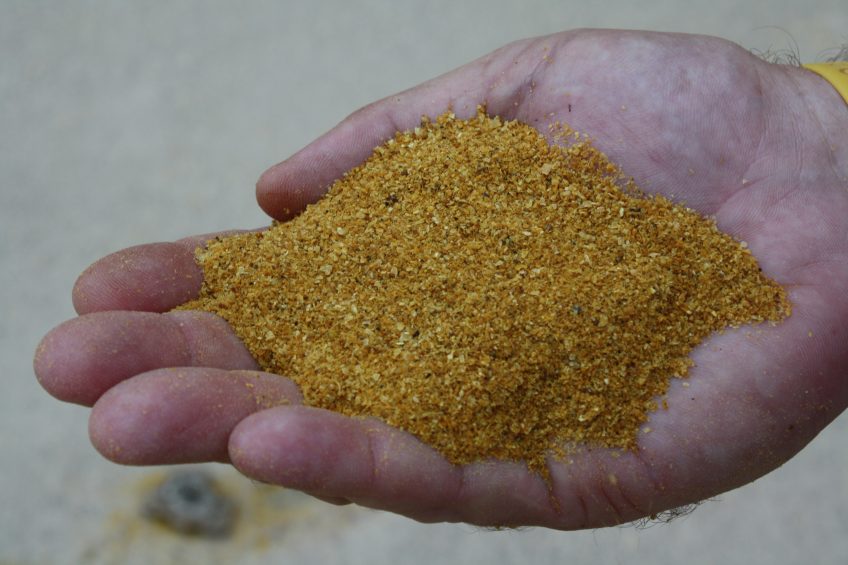Low-oil DDGS looks promising in US grow-finisher trials

Grow-finisher pigs grow equally well when being fed low-oil DDGS instead of conventional DDGS. Also it does not make a difference in carcass characteristics. That was the outcome of US research.
Distillers dried grains with solubles (DDGS) are a byproduct of the distillation process when making ethanol biofuels. In recent years, companies that produce DDGS have begun to remove some of the corn oil for use in biodiesel production.
Cold-fermentation process
The current study was carried out by researchers at the University of Illinois, USA. For the trials, Dakota Gold (Poet Feed Solutions, USA) was used. That is a low-oil source of DDGS produced using a cold-fermentation process. Conventional DDGS contains 10-12% fat, compared with 6-9% in low-oil DDGS.
In an online report, the scientists described how they conducted the trials to determine effects on growth performance and carcass characteristics of feeding low-oil DDGS or conventional DDGS to pigs from weaning to market. The research also tested the effects of feeding diets containing either low-oil DDGS or conventional DDGS in a meal form or in a pelleted form.
Experimental design
In the report, the researchers described how they used a total of 192 barrows and gilts in the experiment. In each phase, 4 diets were fed:
• Meal containing low-oil DDGS;
• Pelleted diets containing low-oil DDGS;
• Meal containing conventional DDGS;
• Pelleted diets containing conventional DDGS.
All diets were based on corn and soybean meal, but had different amounts of DDGS added depending on phase. The researchers wrote that diets were formulated to be equal in standard ileal digestibility (SID) amino acids. The concentration of metabolisable energy (ME) was allowed to vary among diets, with conventional DDGS diets containing slightly more ME than low-oil DDGS diets because of the greater ME of conventional DDGS.
When were the diets fed to the pigs?
The researchers described how pigs were weaned at 21 days of age, and a common phase 1 diet was provided during the initial 7 days post weaning. On day 8 post-weaning, pigs were allotted to experimental diets. Pigs were fed phase 2 diets containing 15% DDGS from days 7 to 21 post weaning and phase 3 diets containing 30% DDGS from days 21 to 43 post weaning.
After the weanling period, pigs were fed grower diets from day 1-38 of the growing-finishing period, early finisher diets from day 38 to 76, and late finisher diets from day 76-94. All diets in the growing-finishing period contained 30% DDGS.
Growth performance
In phase 2 of the nursery period, (days 7-21), pigs fed conventional DDGS had a greater gain:feed ratio than pigs fed diets containing low-oil DDGS. There were no differences in average daily gain, average daily feed intake, or final body weight in phase 2 between pigs fed the two different sources of DDGS. Pigs fed low-oil DDGS did not differ from pigs fed conventional DDGS on any growth parameters in phase 3 (days 21 to 43) or for the overall nursery period.
Average daily gain and average daily feed intake were greater by pigs fed conventional DDGS than pigs fed low-oil DDGS during the initial 38 days of the growing-finishing period. No other differences were observed between pigs fed the two different sources of DDGS during the growing-finishing period.
Greater average daily feed intake
Pigs fed diets in meal form had greater average daily feed intake than pigs fed pelleted diets during the nursery period and the early phases of the growing-finishing period. Pigs fed meal diets also had greater average daily gain in nursery phase 2 and the growing phase than pigs fed pelleted diets. Average daily gain over the total nursery period and the total growing-finishing period was not influenced by diet form.
Pigs fed pelleted diets had a greater gain:feed ratio for both the nursery period and the growing-finishing period compared with pigs fed meal diets.
Carcass characteristics
Pigs fed conventional DDGS and pigs fed Dakota Gold did not differ for any of the carcass characteristics measured in this experiment.
Pigs fed pelleted diets had greater back fat thickness than pigs fed meal diets. In addition, there was a tendency for increased hot carcass weight and decreased fat free lean percentage for pigs fed pelleted diets. These effects were probably due to the greater concentration of metabolisable energy in pelleted diets compared with meal diets.
The research has been carried out by a team around Prof Hans H. Stein, Department of Animal Sciences, University of Illinois, United States.











